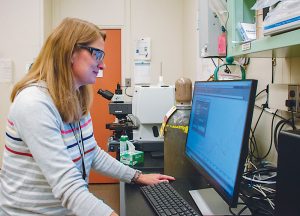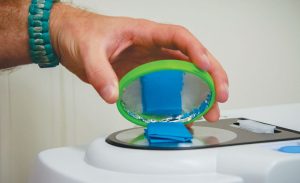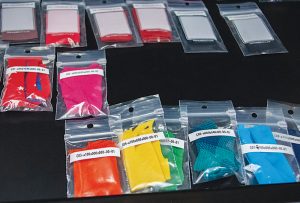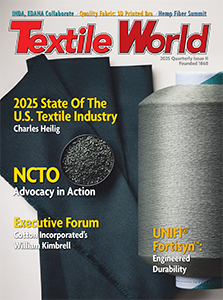
textile samples.
(Images courtesy of Alex Boss, NIST)
NIR-SORT, a new National Institute of Standards and Technology (NIST) database, can be used to identify and help sort textile waste.
TW Special Report
Picture this: You have a bag of heavily used clothes that can no longer be donated taking up space in your closet, so you drop it off at your local recycling center. But what happens to that bag of clothes? You might assume that the clothes would get broken down and reused to make new products.
However, according to the Environmental Protection Agency (EPA), in 2018 around 85 percent of used clothes and textiles headed to land-fills and incinerators1, wasting precious resources and polluting the environment. One reason is that recycling can be more expensive than landfilling, so companies have little incentive to recycle.
To help solve this problem, researchers at the National Institute of Standards and Technology (NIST), Gaithersburg, Md., have developed a database that contains the molecular “fingerprints” of different kinds of textile fibers that can enable more rapid, efficient sorting of fabrics at recycling centers.

“This reference data will help improve sorting algorithms and unlock the potential for high-throughput sorting, which requires less manual labor,” said Amanda Forster, a NIST materials research engineer. Forster leads the NIST project focused on keeping end-of-life textiles in the economy, a process called textile circularity. “That should reduce costs and increase efficiency, making textile recycling more economically viable.”
The problem of textile waste has been growing in recent years. One reason is fast fashion, a business model that has companies churning out large volumes of inexpensive, trendy clothes that are often quickly discarded. New types of textiles, blended textiles, and incomplete or inaccurate labeling also pose significant challenges when it comes to sorting textiles at recycling centers.
At those centers, workers sort clothing using handheld devices that shine near-infrared light. Those devices measure how much of the light passes through or scatters off the fabric, producing a unique pattern — a sort of fingerprint that can identify the type of fibers in the clothing. This technique, called near-infrared (NIR) spectroscopy, can also be used in automated conveyor belt systems. However, current techniques still require a lot of manual labor.
In recent years, recycling equipment manufacturers have increasingly used machine learning and artificial intelligence to improve their sorting algorithms. To train these algorithms, they need high-quality reference data.

That’s where NIST’s database comes in. Called the Near-Infrared Spectra of Origin-defined and Real-world Textiles, or NIR-SORT, it contains 64 different fabric types along with the NIR fingerprints they produce. The database includes single fiber types, such as cotton and polyester; blended fiber types including spandex blends; and real-world fabrics taken from thrift stores. Manufacturers of NIR scanner systems can use this database to train and test their sorting algorithms and improve the performance of their products.
“The difficulty comes in when fibers are similar, like cotton or hemp,” noted NIST research chemist Katarina Goodge, who led the development of the database. “That means that the near-infrared signal is similar. The same is true with a cotton and polyester blend. Is this a new fiber or a blend of two or more fibers? AI can help make the decision-making process more accurate.”
Because NIST is the nation’s measurement institute, it has the equipment and expertise to fill this database with very high-quality spectra. This hopefully means fewer errors when identifying fabrics, which will lead to more textiles recycled.
This research stems from a key initiative of a report by NIST2 in which experts recommended the development of better technology for identifying and sorting textiles and clothing. These efforts are part of NIST’s Circular Economy Program3, which develops measurement science and methods to support an economy where materials are designed to retain their value through repeated reuse, repair and recycling, with disposal as a last resort.
References:
1 https://www.epa.gov/facts-and-figures-about-materials-
waste-and-recycling/textiles-material-specific-data
2 https://nvlpubs.nist.gov/nistpubs/SpecialPublications/
NIST.SP.1500-207.pdf
3 https://www.nist.gov/circular-economy
Editor’s Note: The database is free and available to download from NIST’s Public Data Repository: https://data.nist.gov/od/id/mds2-3325
2025 Quarterly Issue I




